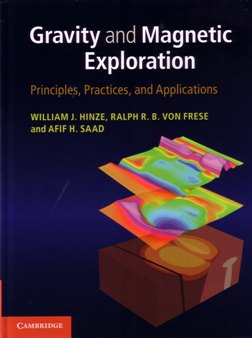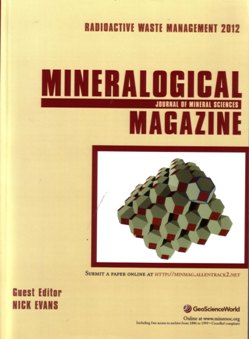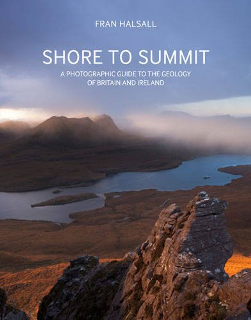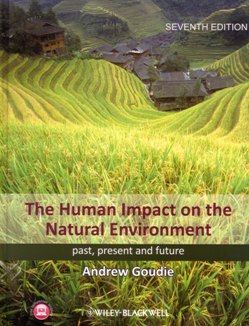 Gravity and Magnetic Exploration
Gravity and Magnetic Exploration
This June the Geological Society was selling a copy of Nettleton’s 1971 classic ‘Elementary Gravity and Magnetics’, which covered both disciplines in 121 pages. Now, however, magnetics has become the inevitable ‘must have’ in airborne geophysical surveys, and the last 10 years have seen an explosion in the use of airborne gravity and gradiometry. Not surprisingly, Nettleton’s most recent successors now need more than 500 pages, and a dedicated website, to cover the same ground.
In their book the separate sections for gravity and magnetic s are divided into chapters on basic method, underlying mathematics, anomaly sources, data acquisition, data processing and interpretation. Each section has a general introduction and is rounded off with a chapter on applications and an appendix on data processing. The application chapters are brief, but are supported by an additional 282 pages on the website.
Each chapter begins with an overview and ends with a summary of ‘Key Concepts’, and these are actually essential, because, although the authors emphasise the importance of GPS technology in the field, they unfortunately failed to recognise that readers also need navigation aids. Their index is too short, and their choice of key words is eccentric. For example, they choose to list some remarkably obscure satellites but not either gravity gradiometry or tilt-angle interpretation, two topics actually quite adequately covered.
The lack of colour maps is also disappointing. The grey half-tones are almost unusable, and their full-colour counterparts on the website are sometimes little better. Thus any chance to communicate excitement at the spectacular magnetic images of entire continents or at the intricacies of sea-floor spreading revealed by gravity has been lost, and one is left wondering if it was even recognised.
The authors, one feels, do not ‘do’ excitement. They make a serious and conscientious attempt to cover the whole of a rapidly expanding discipline, but are unlikely to attract new converts to it. A shorter book would have done that job better, with no loss of content, simply by tighter writing. Almost every sentence is at least half as long again as it needs to be, and this matters when writing for an industry where everyone is chronically short of time.
Reviewed by John Milsom
GRAVITY AND MAGNETIC EXPLORATION. PRINCIPLES, PRACTICES AND APPLICATIONS.
WILLIAM J, HINZE, RALPH R B VON FREESE & AFIF H SAID. Published by Cambridge University Press 2013. ISBN 978-0-521-87101-3. 515pp. List Price: £40.00
www.cambridge.org/gravmag
 Radioactive Waste Management 2012
Radioactive Waste Management 2012
Based upon the outcomes of the themed conference on the geological disposal of radioactive waste held at the University of Loughborough (October 2011), this Mineralogical Society volume presents a concise and detailed summary of the current, independently conducted scientific and technological research underpinning the challenges associated with the long term management of radioactive waste in the UK.
Reflecting the structure of the conference sessions, the volume is organised into nine thematic sections, each beginning with an introductory paper authored by the key UK stake holder, the Nuclear Decommissioning Authority (NDA), outlining its view on the particular theme. This is followed by wide-ranging peer-reviewed papers from independent academic, industrial and supply chain geoscience research contributors.
The nine thematic sections presented are comprehensive and cover the full range of geoscience research in each area: Section 1: introduction (1 paper), Section 2: wasteforms, containment materials and criticality (12 papers), Section 3: engineered barriers – near-field (10 papers), Section 4: geosphere – far-field (nine papers), Section 5: biosphere and microbial sciences (six papers), Section 6: gas (10 papers), Section 7: radionuclide transport (seven papers), Section 8: international aspects (two papers) and Section 9: general issues (six papers).
The papers presented in the main sections of the volume are extensive and varied, demonstrating the considerable independent research effort being undertaken to support the robust scientific and technological basis of the UK geological disposal programme. All sections are well-written and edited, concisely laid-out with clear and appropriate figures, photographs and data-tables, features that one has come to expect from a Mineralogical Society publication.
A major stated objective of the conference was to make the latest independent geoscientific research on the geological disposal of radioactive waste (primarily in relation to the UK context) publicly available. In my opinion this has been amply fulfilled by the publication of this volume, and is an impressive achievement.
The primary readership is thought to be practising geoscientific professionals within the UK radioactive waste management industry. However, this volume also provides a welcome (and long overdue) public information source for the general scientific or environmentally-concerned reader, documenting current progress and contribution of independent geoscience research to the radioactive waste management and disposal strategy. A recommended read and valuable reference work.
Reviewed by Mark Griffin
RADIOACTIVE WASTE MANAGEMENT 2012
NICK EVANS (Ed.) Mineralogical Magazine Vol 76 (8), #501. December 2012. Mineralogical Society. ISSN 0026-461X. Sbk. pp2865-3507.
 Shore to Summit
Shore to Summit
This ‘Photographic Guide to the Geology of Britain and Ireland’ is sumptuously presented in hardback, with high production values on high quality paper, making the presentation of the photographs large and spectacular. As well as including geology, the photos are very artistically pleasing. The text that accompanies the photographs is well written, even rather simple and a bit sparse! Even so, there is a comprehensive glossary for the non-specialist, including some description of rock types, photographic details, suggestions for further reading and useful websites.
The book is suitable for everyone, particularly anyone interested in landscapes. It includes 100 beautiful, often dramatic photographs of such classic localities as the white Cliffs of Dover, the Long Mynd and Wrekin, Anglesey, the Old Man of Hoy and Helvellyn, arranged in order of formation and telling the geological story of the evolution of the British Isles.
The author describes volcanic eruptions, the collision of continents, upheavals and many deposition and erosion events. There are also diagrams describing processes such as folding and plate tectonics. The text describes the landscapes in terms of how they were formed, together with some idea of the history, legend, folklore and archaeology of each area.
Halsall paints vivid historical pictures of the arrival of agriculture, deforestation, industrial revolution, and consequent environmental changes. Literature and music associated with the landscapes featured are mentioned (Mendelssohn and Fingal’s Cave, James Joyce and Doldrum Bay, etc.). The author mentions modern day amenity-use of landscapes, such as rock-climbing, and takes account of the effects of the climate and weather.
She talks of the Anthropocene and the Gaia hypothesis, and tells of the catastrophic events that have occurred since the start of life and of the more recent changes in weather and climate (e.g. the modern absence of ‘April showers’, increased incidence of floods, plants flowering at unusual times and the thinning of polar ice). She repeats the familiar mantra that we have been conducting ‘an experiment with the atmosphere’ whose outcome is ‘uncertain’. She wonders what will happen in the future; will we be called ‘the plastic age’ by future geologists who find the material deposited in our era?
This is an excellent general book for everyone – it is not a detailed textbook for the specialist! Halsall’s perspective on the world is unusual and very stimulating. The book is interesting for all and must be recommended most strongly (and outstanding value at £20). Anyone should be proud to have it on their coffee-table.
Reviewed by Steve Rowlatt
SHORE TO SUMMIT: A PHOTOGRAPHIC GUIDE TO THE GEOLOGY OF BRITAIN AND IRELAND
FRAN HALSALL Published by Frances Lincoln Ltd. 2013 Hardback ISBN 978-0-7112-3348-5 192pp List Price: £20
www.franceslincoln.com
 Human Impact on the Natural Environment
Human Impact on the Natural Environment
How will it all end? Detailing the numerous ways humans are impacting the natural environment - with many scary graphs - that is the Big Question with which this book leaves the reader. It covers all impacts you could think of, and some you might not - including “desecration of cave formations by speleologists”.
The historical context is nicely set, explaining how humans moulded landscapes over millennia – from the first use of fire, to tree-cutting, domestication of animals, and modification of water bodies. Impacts were not at forst necessarily negative, with many societies living in sustainable harmony with nature. The big change now is our unprecedentedly growing population, affluence and industrialisation.
Chapter 1 provides a short history of our growing concerns. From the 1700s, the impact of European colonisation on uninhabited lands was observed. Gradually, a better understanding of the impact of deforestation, on water flows, recharge and erosion, emerged. In the mid 1800s, Mary Somerville deduced that every species played an important role, and destroying even one upsets nature’s balance. In the 1900s, the sustainability of relentless development began to be questioned, and recently, we “have begun to ponder whether the world is entering a spasm of unparalleled human-induced modification”.
The main part of the book reports on observed impacts, with chapters on each key subject area: vegetation, animals, soil, water, geomorphology and climate. A second part focuses on the future, principally projections of climate change impacts. This approach seems out of line with a concluding observation that “global warming is not the only big global issue we face. Of immense and in many cases more immediate importance are other aspects of global change”, mentioning land use, biodiversity, water shortage and quality, soil, erosion, salinisation, and pollution. While it is good to see them acknowledged, an opportunity to provide more detail and emphasis on future trends in these other critical areas seems to have been missed.
Solutions will not be easily found or applied, and some may themselves generate negative impacts, with biofuels cited as an example. The author offers little by way of solutions, and even the question of whether to be pessimistic or optimistic – where, indeed, it all may end – are left (perhaps unsurprisingly) open.
Now in its seventh edition since 1981, it is up-to-date with 2013 data and references. Overall, it is an excellent and well illustrated reference that helps counter the risk of single-issue fixation by virtue of its measured, broad and yet also detailed approach.
Reviewed by Peter Easton
THE HUMAN IMPACT ON THE NATURAL ENVIRONMENT - PAST, PRESENT AND FUTURE (7TH EDN.)
ANDREW GOUDIE Published by Wiley-Blackwell 2013 ISBN 978-1-118-57658-8 (paperback) 422pp £34.95 (Also available as hard cover and e-book)
www.wiley.com